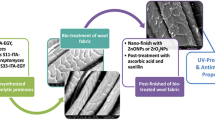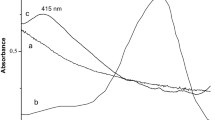Abstract
The stain resistance and intrinsic hydrophobic features of wool are the most important problems which have negative impacts on various aspects of wool and prompt scientists to find a solution over the past decades. Zinc oxide nanoparticles (ZnO-np) were successfully synthesized and stabilized on natural protein wool using the impregnation process with butane tetra carboxylic acid (BTCA) as eco-friendly cross-linker. In this research, these particles were linked to wool surface by BTCA and also sodium hypophosphite was used as a catalyst. The self-cleaning technology of ZnO-np deposited on the wool fabrics was followed by degrading of Direct Blue 71 and Disperse Red 1 as synthetic stains and also determined by degrading rate of food stains such as coffee and black mulberry under the ultraviolet irradiation. The hydrophilicity was monitored by water drop absorption time. The central composite design was used for different variables based on Design of Expert software. The analysis of variance was utilized to obtain the optimum models for wool with maximum color reductions and minimum absorption time. The presence of ZnO-np on the wool surface was confirmed with scanning electron microscopy. Further transmission and absorbance spectra validated the UV protection properties of ZnO-np-treated wool. The results showed that increasing the amount of ZnO-np leads to enhanced reduction of synthetic color stains than food color stains on the treated wool fabric, while the fabric became more hydrophilic.







Similar content being viewed by others
References
Abd El-Hady MM, Farouk A, Sharaf S (2013) Flame retardancy and UV protection of cotton based fabrics using nano ZnO and polycarboxylic acids. Carbohydr Polym 92:400–406
Allam OG, El-Sayed A, Kantouch A, Haggag K (2009) Use of sericin in felt proofing of wool. J Nat Fibers 6:14–26
Arivithamani N, Mary SA, Kumar MS, Giri Dev VR (2014) Keratin hydrolysate as an exhausting agent in textile reactive dyeing process. Clean Technol Environ Policy 16:1207–1215
Bahi A, Jones JT, Carr CM, Ulijin RV, Shao J (2004) Surface characterization of chemically modified wool. Text Res J 77:937–945
Bahtiyari MI, Duran K (2013) A study on the usability of ultrasound in scouring of raw wool. J Clean Prod 41:283–290
Behzadnia A, Montazer M, Rashidi A, Rad MM (2014) Sonosynthesis of nano TiO2 on wool using titanium isopropoxide or butoxide in acidic media producing multifunctional fabric. Ultrason Sonochem 21:1815–1826
Box GEP, Hunter WG, Hunger JS (1978) Statistics for experimenters: an introduction to design, data analysis and model building, 1st edn. Wiley, New York
Bozzi A, Yuranova T, Guasaquillo I, Laub D, Kiwi J (2005) Self-cleaning of modified cotton textiles by TiO2 at low temperatures under daylight irradiation. J Photochem Photobiol A Chem 174:156–164
Brown AE, Hornstein LR, Harris M (1951) The chemical modification of wool-treatment with formaldehyde solutions. Text Res J 21:222–227
Cao Q, Yu Q, Connell DW, Yu G (2013) Titania/carbon nanotube composite (TiO2/CNT) and its application for removal of organic pollutants. Clean Technol Environ Policy 15:871–880
Chen D, Tan L, Liu H, Hu J, Li Y, Tang F (2009) Fabricating superhydrophilic wool fabrics. Langmuir 26:4675–4679
De Groot A, Le Coz C, Lensen G, Flyvholm M, Maibach H, Coenraads P (2010) Formaldehyde-releasers: relationship to formaldehyde contact allergy. Formaldehyde-releasers in clothes: durable press chemical finishes. Part 1. Contact Dermatitis 62:259–271
Demir A, Karahan HA, Ozdogan E, Oktem T, Sventekin N (2008) The synergetic effects of alternative methods in wool finishing. Fibers Text East Eur 16:89–94
Euvananont C, Juinin C, Inpor K, Limthonkul P, Thanachayanont C (2008) TiO2 optical coating layers for self-cleaning applications. Ceram Int 34:1067–1071
Farouk A, Textor T, Schollmeyer E, Tarbuk A, Marija A (2009) Sol–gel derived inorganic–organic hybrid polymer filled with nano-ZnO as ultraviolet protection finish for textiles. Autex Res J 9:114–120
Greene LE, Law M, Tan DH, Montano M, Goldberger J, Somorjai G, Yang P (2005) General route to vertical ZnO nanowire arrays using textured ZnO seeds. Nano Lett 5:1231–1236
Hsieh SH, Huang ZK, Huang ZZ, Tseng AZ (2004) Antimicrobial and physical properties of woolen fabrics cured with citric acid and chitosan. J Appl Polym Sci 94:1999–2007
Kandula S, Jeevanandam P (2014) Visible-light-induced photodegradation of methylene blue using ZnO/CdS heteronanostructures synthesized through a novel thermal decomposition approach. J Nanopart Res 16:2452–2459
Kantouch A, Bendak A, Sadek M (1978) Studies on the shrink-resist treatment of wool with potassium permanganate. Text Res J 48:619–624
Khalilzadeh A, Fatemi S (2014) Modification of nano-TiO2 by doping with nitrogen and fluorine and study acetaldehyde removal under visible light irradiation. Clean Technol Environ Policy 16:629–636
Kim YH, Nam CW, Choi JW, Jang J (2003) Durable antimicrobial treatment of cotton fabrics using N-(2-hydroxy) propyl-3-trimethylammonium chitosan chloride and polycarboxylic acids. J Appl Polym Sci 88:1567–1572
Li YS, Jiao ZH, Yang N, Gao H (2009) Regeneration of nano-ZnO photocatalyst by the means of soft-mechanochemical ion exchange method. J Environ Sci 21:S69–S72
Lin YC (2013) Applying Ag–TiO2/functional filter for abating odor exhausted from semiconductor and opti-electronic industries. Clean Technol Environ Policy 15:359–366
Long J, Cui C, Wang L, Xu H, Yu Z, Bi X (2013) Effect of treatment pressure on wool fiber in supercritical carbon dioxide fluid. J Clean Prod 43:52–58
Lugovskoy S, Nisnevitch M, Zinigrad M, Wolf D (2008) Mechanochemical synthesis of salicylic acid–formaldehyde chelating co-polymer. Clean Technol Environ Policy 10:279–285
Mansour HF (2010) Environment and energy efficient dyeing of woollen fabric with sticta coronate. Clean Technol Environ Policy 12:571–578
Mansour HF, Heffernan S (2011) Environmental aspects on dyeing silk fabric with sticta coronata lichen using ultrasonic energy and mild mordants. Clean Technol Environ Policy 13:207–213
Meenatchisundaram S, Devaraj M, Rai CL, Nadarajan KM (2014) An integrated approach for enhanced textile dye degradation by pre-treatment combined biodegradation. Clean Technol Environ Policy 16:501–511
Montazer M, Pakdel E (2010) Reducing photoyellowing of wool using nano TiO2. Photochem Photobiol 86:255–260
Montazer M, Pakdel E (2011) Self-cleaning and color reduction in wool fabric by nano titanium dioxide. J Tex Ins 102:343–352
Montazer M, Seifollahzadeh S (2011) Enhanced self-cleaning, antibacterial and UV protection properties of nano TiO2 treated textile through enzymatic pretreatment. Photochem Photobiol 87:877–883
Montazer M, Pakdel E, Bameni Moghadam M (2011) The role of nano colloid of TiO2 and butane tetra carboxylic acid on the alkali solubility and hydrophilicity of proteinous fibers. Colloids Surf A 375:1–11
Montazer M, Pakdel E, Bameni Moghadam M (2012) Superior self-cleaning features on wool fabric using TiO2/Ag nanocomposite optimized by response surface methodology. J Appl Polym Sci 125:E356–E363
Montgomery DC (2004) Design and analysis of experiments, 6th edn. Wiley, New York
Morris RE, Krikanova E, Shadman F (2004) Photocatalytic membrane for removal of organic contaminants during ultra-purification of water. Clean Technol Environ Policy 6:96–104
Nair G, Nirmala M, Rekha K, Anukaliani A (2011) Structural, optical, photo catalytic and antibacterial activity of ZnO and Co doped ZnO nanoparticles. J Mater Sci Lett 65:1797–1800
Navid P, Khoshgoftar Manesh MH, Marigorta AMB (2014) Optimal design of cogeneration system based on exergoenvironmental analysis. Clean Technol Environ Policy 16:1045–1065
Nazari A (2014) Proteases pretreatment on wool to enhance durable antimicrobial and UV protection with nano TiO2 and polycarboxylic acids using RSM. J Tex Ins 105:620–630
Nazari A, Montazer M, Rashidi A, Yazdanshenas M, Anary-Abbasinejad M (2009) Nano TiO2 photo-catalyst and sodium hypophosphite for cross-linking cotton with poly carboxylic acids under UV and high temperature. Appl Catal A Gen 371:10–16
Nazari A, Montazer M, Bameni-Moghadam M, Anary-Abbasinejad M (2011) Self-cleaning properties of bleached and cationized cotton using nanoTiO2: A statistical approach. Carbohydr Polym 83:1119–1127
Nazari A, Montazer M, Afzali F, Sheibani A (2013a) Optimization of proteases pretreatment on natural dyeing of wool using response surface methodology. Clean Technol Environ Policy 16:1081–1093
Nazari A, Montazer M, Dehghani-Zahedani M (2013b) Mothproofing of wool fabric utilizing ZnO nanoparticles optimized by statistical models. J Ind Eng Chem. doi:10.1016/j.jiec.2013.12.112
Nazari A, Montazer M, Dehghani-Zahedani M (2014) Simultaneous dyeing and mothproofing of wool against Dermestes maculatus with madder optimized by statistical model. Clean Technol Environ Policy. doi:10.1007/s10098-014-0745-4
Peplow M (2004) Self-cleaning clothes. Nature 429:620
Rashid K, Suresh Kumar Reddy K, Al Shoaibi A, Srinivasakannan C (2013) Sulfur-impregnated porous carbon for removal of mercuric chloride: optimization using RSM. Clean Technol Environ Policy 15:1041–1048
Reddie RN, Nicholls CH (1971) Some reactions between wool and formaldehyde. Text Res J 41:841–852
Shams-Nateri A (2011) Reusing wastewater of madder natural dye for wool dyeing. J Clean Prod 19:775–781
Shao J, Fan Q (2012) Eco dyeing, finishing and green chemistry. Adv Mat Res 441:33–37
Sikdar S (2007) Sustainability and recycle–reuse in process systems. Clean Technol Environ Policy 9:167–174
Sikdar S, Jain R (2002) Environmental management is inherently multi-disciplinary. Clean Technol Environ Policy 3:335
Sugashini S, Meera Sheriffa Begum KM (2013) Optimization using central composite design (CCD) for the biosorption of Cr(VI) ions by cross linked chitosan carbonized rice husk (CCACR). Clean Technol Environ Policy 15:293–302
Tung WS, Daoud WA (2009) Photocatalytic Self-cleaning Keratins: a feasibility study. Acta Biomater 5:50–56
Tung WS, Daoud WA (2011) Self-cleaning fibers via nanotechnology: a virtual Reality. J Mater Chem 21:7858–7869
Vedaraman N, Shamshath Begum S, Srinivasan SV (2013) Response surface methodology for decolourisation of leather dye using ozonation in a packed bed reactor. Clean Technol Environ Policy 15:607–616
Visa M, Pricop F, Duta A (2011) Sustainable treatment of wastewaters resulted in the textile dyeing industry. Clean Technol Environ Policy 13:855–861
World Health Organization, International Agency for Research on Cancer (2006) Monographs on the evaluation of carcinogenic risks to humans, vol 88. World Health Organization, International Agency for Research on Cancer, Lyon, p 277–280
Yuranova T, Laub D, Kiwi J (2007) Synthesis, activity and characterization of textiles showing self-cleaning activity under daylight irradiation. Catal Today 122:109–117
Zhang F, Yang J (2009) Preparation of nano-ZnO and its application to the textile on antistatic finishing. Int J Chem 1:18–22
Acknowledgments
I would like to express my appreciation to Yazd Branch, Islamic Azad University for its support of research project under the title of enhancing the stability of ZnO-np in photo-degradation of natural and synthetic stains of wool fabrics using cross-linking agent.
Author information
Authors and Affiliations
Corresponding author
Rights and permissions
About this article
Cite this article
Shirgholami, M.A., Nazari, A. & Mirjalili, M. Statistical optimization of self-cleaning technology and color reduction in wool fabric by nano zinc oxide and eco-friendly cross-linker. Clean Techn Environ Policy 17, 905–919 (2015). https://doi.org/10.1007/s10098-014-0842-4
Received:
Accepted:
Published:
Issue Date:
DOI: https://doi.org/10.1007/s10098-014-0842-4




